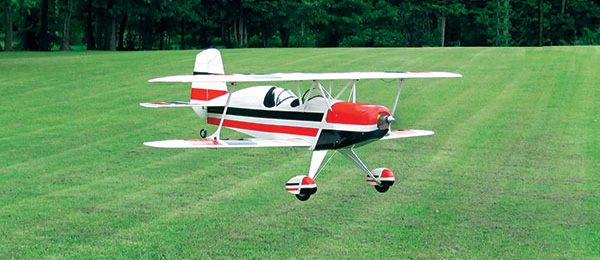Laminations
Scale
By Rob Caso | [email protected]
As seen in the Spring 2023 issue of Park Pilot.
I continue to use laminated parts in my models for the following reasons:
- Laminated parts are generally stronger than single parts that are made from the same material.
- The wood’s grain can be used to your advantage.
- A laminated part can be made lighter in total than a single part of the same finished thickness.
I frequently use laminations for empennage outlines where both weight and strength are critical factors. Many designs use either a sheet core or outlines that are cut from flat sheet to produce the shape of a curved rudder or elevator. Even with having lightening holes, a solid core is almost always heavier than—and usually not as strong as—a laminated outline. Similarly, thin outlines that are cut from sheet are weaker than laminations because the grain of the wood does not follow the curve of the outline.

The curved lamination for a Pfalz rudder is held true by polycarbonate strips.
With lamination, a ply of multiple strips is formed, and the grain of these pieces follows the outline of the surface. The glue also adds strength to the assembly. While the grains of these parts run parallel to each other through the curve, the wood grain in each strip does not align as it would in a single wood part, thus adding strength.

For certain laminations, a dedicated form might be necessary.
On the rudder of my inprocess 1/6-scale Pfalz D.III, I used a six-piece lamination of .0625-inch medium-weight balsa strips. This is easy to do because the curve of the outline is so gentle. Some plans recommend cutting a planform of the part to be outlined, but I have oftentimes found this to be unnecessary. Instead, I align the lamination with the plans by using strips of polycarbonate as a fence to both keep the outline true and to protect the wet lamination from being kinked with the pins. Because the fence is placed on both sides of the lamination, this also keeps the strips in close contact while they are drying. Titebond III (titebond.com) is my adhesive of choice for this job.

The finished empennage for Rob Caso’s HB-12 has a combination of laminated and cut outlines.
Laminated strips can also be used for tight curves, such as the chine of the hull on my FBA flying boat. The 1/8-inch square strips that I tried initially couldn’t make the curve, but a couple of 1/16 x 1/8-inch strips laminated together did so easily. I also laminated the bulkheads for the model, using a pair of 1/16-inch pieces rather than a solid 1/8-inch part. Once again, the differential grain and the glue added a lot of strength with little weight.

The fuselage sides of the HB-12 consist of a cross-grain lamination to provide strength in two directions and prevent warps.
Some designs call for a plywood part—let’s say 1/8 inch. I have found that laminating a piece of 1/64-inch plywood to an internal core of, in this case, a piece of hard 3/32-inch balsa, is just as strong and noticeably lighter. Note that plywood used in laminations should be lightly sanded to remove the manufacturing glaze that would inhibit glue penetration.

The 1/16-inch sheet balsa laminated bulkheads for Rob’s FBA flying boat.
For high-stress applications, I have been known to laminate fiberglass cloth between a pair of plywood parts, using slow-set epoxy as the adhesive. When doing “flat” laminations such as this, I always weigh down the part on a flat surface. Water-based wood glue tends to warp the parts while drying and causes hem to lift at their edges. Waxed paper can be used to keep the part from being glued to the table or to the weights.

For the jig-built FBA, a pair of laminated 1/16-inch stringers were used for its 1/8-inch square chine.






